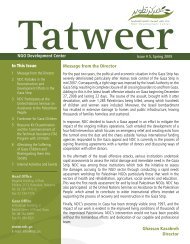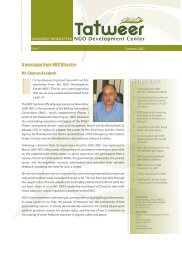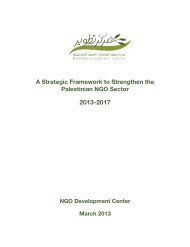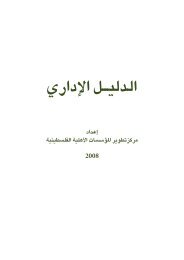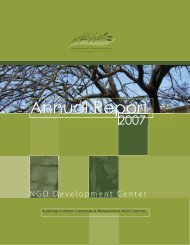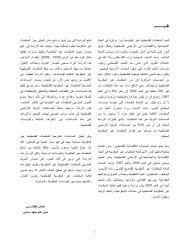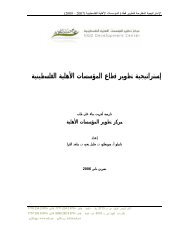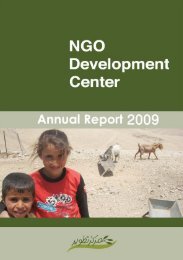Tracking External Donor Funding.pdf - NDC
Tracking External Donor Funding.pdf - NDC
Tracking External Donor Funding.pdf - NDC
You also want an ePaper? Increase the reach of your titles
YUMPU automatically turns print PDFs into web optimized ePapers that Google loves.
IV. Review of Welfare Study (1998)<br />
IV.1 Profile of <strong>Donor</strong>s to Palestinian NGOs (1995-1998)<br />
In 1998 the Welfare Association commissioned a study by Dr. Sari Hanafi, Profile of <strong>Donor</strong>s to Palestinian NGOs,<br />
which would later become the quantitative foundation behind the book The Emergence of a Globalized Palestinian Elite<br />
(2005). The 16 week study surveyed 100 (of the estimated 230) foreign donor organizations, and approximately 50% of<br />
those surveyed returned completed questionnaires (50). Dr Hanafi divided donor organizations into four broad<br />
categories: governmental (GOV), inter-governmental (IGO), non-governmental (NGO) and international nongovernmental<br />
(INGO).<br />
IV.2 Research Limitations<br />
Dr Hanafi admits that, without first mapping Palestinian NGOs (Welfare, 1998:9), a true picture of aid may be difficult<br />
to paint. The survey was unable to properly access the geographic distribution of donor funding to Palestinian NGOs<br />
and did not clearly define the location of an organization versus the location of its projects, activities and beneficiaries.<br />
The total amount calculated from the data for disbursements for Palestinian NGOs projects from 1995 to 1998, USD<br />
232 million, must be viewed as low, since disbursements by some larger donors such as Welfare Association, World<br />
Bank PNGO Project and UNICEF are not included.<br />
IV.3 Results Breakdown by Sector<br />
1. Education and Health remain the most important sectors of interest for NGOs, although responsibility for them was<br />
transferred to the PA four years ago.<br />
2. Although the main Palestinian economic sector is Agriculture, it remains neglected or ignored by donors, with only<br />
7.7% of total PNGO funding being directed to it over a four year period. Of this small amount, the Palestinian<br />
Agricultural Relief Center (PARC) commands over 2/3.<br />
3. Traditional sectors, such as Culture and Social Services have a small share with 17 million each (approximately 7%<br />
separately for a cumulative amount of 14% of the total).<br />
4. Micro-credit and the Private Sector Support lag far behind other sectors, indicating the lack of NGO activity in the<br />
economic sphere. Income generation and micro credit only received 3.7% of total funding, with most of it directed<br />
towards projects for women.<br />
5. There is a dramatic shift from Emergency Relief to Development Assistance since the end of 1997. Relief activities<br />
only take up 0.9% of total NGO funds. This is also due to the fact that local NGOs do not often operate in this<br />
sector, and the brunt of emergency aid is channeled through major IGOs, such as UNRWA.<br />
6. There is a new interest among PNGOs in the Environment, but this interest has not resulted in an increase in donor<br />
funding to the sector.<br />
7. Infrastructure was primarily seen as function of the individual municipalities or the PNA and only comprised 2.9%<br />
of total funding to the NGO sector.<br />
8. Human Rights and Democracy have continually increased over the period studied and now sit at 10.5% of total<br />
funding to PNGOs.<br />
9. The funding of Institution-Building was 8 million, approximately 3.5%, but it is difficult to differentiate between<br />
the resources that are directed towards either equipment or training.<br />
10. Development also includes any unspecified project or projects that are multi-sectoral.<br />
11. Dr. Hanafi’s study included as subsectors projects targeting Women (6% of total funding) and the Needs of the<br />
Handi-capped (10% of total funding).<br />
IV.4 Geographic Trends Identified<br />
1. Despite the general view that Jerusalem is ignored by donors, the city enjoys the largest share of WB funding<br />
(26%). The second is Ramallah with 7.7%, then Bethlehem with 6.9%, Nablus with 5.6% and Hebron with 5.3%.<br />
2. Bethlehem benefits disproportionately compared to their population, especially when compared to Nablus or<br />
Hebron.<br />
87


